Features and selection of punches for leather and fabric
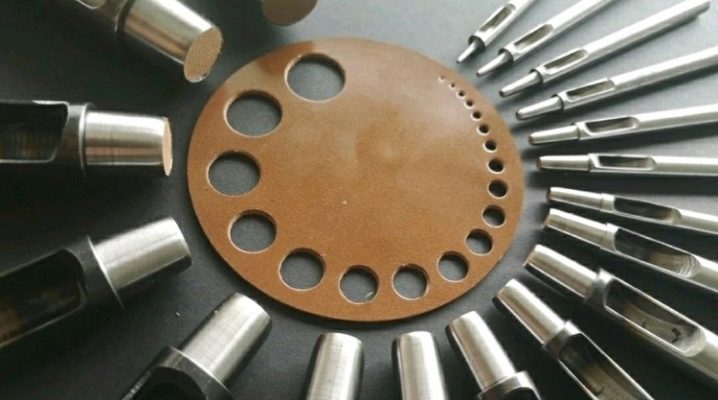
Many tanners in their business use special devices that make holes in the material of various diameters. Punches are used not only for leather products. Using the tool allows you to make holes in cardboard products, tarpaulins, various sheet materials.
The presence of a sharpened edge allows you to cut into the work surface, which leads to a perfectly flat hole of the required size. The article will discuss what the tool is, what types of products exist, as well as the rules for using the punch and the choice of products.
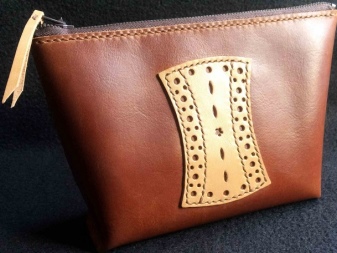

What it is?
The punch is a necessary tool that tanners use for various types of work related to the preparation of leather and other dense materials before stitching. Such materials have great rigidity, which makes it difficult to work with them without special tools. Some manipulations cannot be done efficiently without using such a hole punch.
The tool is suitable not only for working with leather goods, but also for thick fabric, tarpaulin, leatherette. After carrying out such a manipulation, very even and high-quality holes are obtained, which cannot be obtained using an awl, sewing needle or drill.
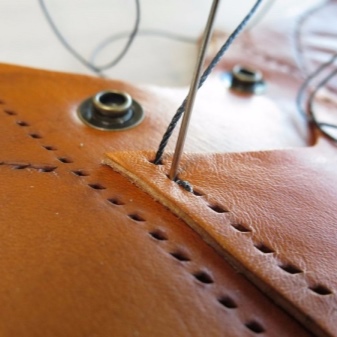

Species overview
Leather has a high density, so a needle, awl or other sewing devices are not always suitable for punching it. To solve this problem, special tools are used. Different types of punches should be distinguished:
- line models;
- curly;
- revolving version;
- ring;
- end.
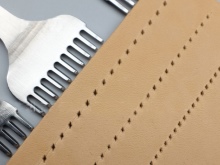
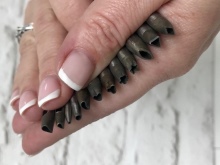
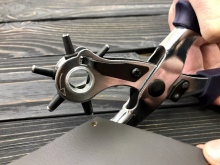
Outwardly, line punches can be compared with a table fork or a comb. They have special spikes located in a single line, standing at the same distance. On such a punch, needles from one to 6 pieces can be located. Install them along the line where the future seam will pass. Impact on the end face of the tool pierces the material and punching holes in it. The sewing speed depends on the number of spikes on the line punch. After punching holes, the thorns are removed, and the comb is displaced, observing an even step for the seam.
Inline models can be divided into 2 types. In the first case, the product works on the principle of a cutter, pressing and piercing the hole, which leads to the expansion of the material. In the second case, using a punch, a small cavity is cut out with complete removal of material. After applying it, neat grooves will remain on the skin or other material.
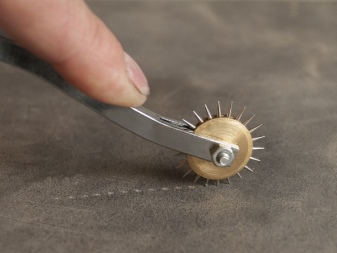
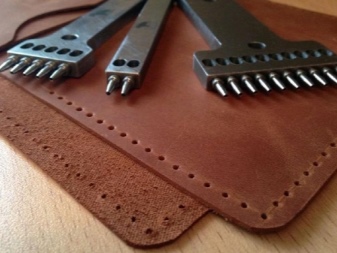
The thorns have different shapes. More often you can see round or semicircular options, they are also diamond-shaped, in the form of a triangle, oblique or rectangular. In addition, you should pay attention to what is the thickness of the cross section of the needles, what is the distance between them. So, the French seam is more often done using oblique hole punches. Usually they are used when sewing a purse or processing straps on a wristwatch.
When sewing more powerful and coarse models, it is better to choose cutters that have a large diameter of spikes and with an increased pitch. This will allow you to sew the product using thicker threads. There are no universal tools that are suitable for all cases, which is why many craftsmen have in their arsenal a set of such hole punchers with different combs. Chinese hole punches are similar to Japanese diamond-shaped products.
The diamond-shaped set contains the classic number of tools with 1,2, 4 and 6 teeth, with a distance of 5 mm between them.
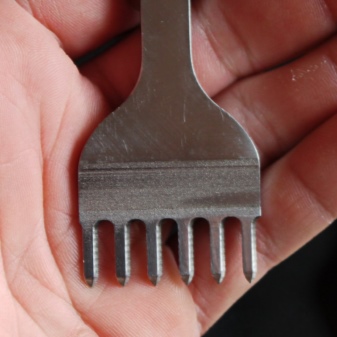

Revolving punchers look like pliers, on one side of which there is a revolver for punching holes. Using this option, it is necessary to turn the tool and install the required type of spike. It remains to lay the material to be processed and squeeze the hole punch, making a hole. Most often, such revolving models have spikes (6 pcs.) With a hole diameter of 2-4.5 mm. The blocker allows you to exclude the scrolling of the tool. The choice of such a model punches one hole at a time, which excludes the possibility of choosing it for seams. One of the main uses of revolving options is to create small holes, for example, for a belt or for a bag strap.
The use of curly, as well as annular options involves punching holes with the removal of part of the material that gets inside. Thanks to this equipment, large-sized cuts can be made. Typically, these punches look like a tube with a pointed end. By applying the equipment with the pointed part to the skin or other material and hitting the butt end, an eruption is produced. The range of such models is quite wide. With the help of such products, you can cut not only a circle or an oval, but also repeat the outlines of geometric shapes, stars, eyes. Round models are usually sold in sets, with tubes ranging from 2 to 22 mm. However, curly punches can be purchased separately.

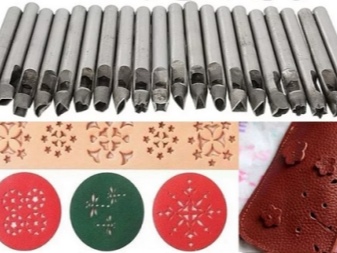
The face tool is intended for cutting the skin. Widely used facers designed for belts, representing a bent plate of steel. It is used to cut ribbons in the manufacture of leather belts. End models can have other shapes.
Separately, it is worth highlighting the tools for punching hunting wads, necessary for cartridges. Such devices have a more impressive diameter in comparison with other options. Their diameter must correspond to the caliber of the cartridge. The main purpose of hunting hole punches is to cut circles out of dense material. It is usually used for cutting felt and cardboard circles.
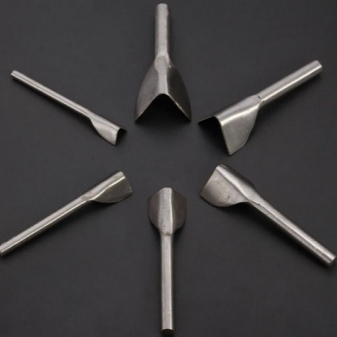
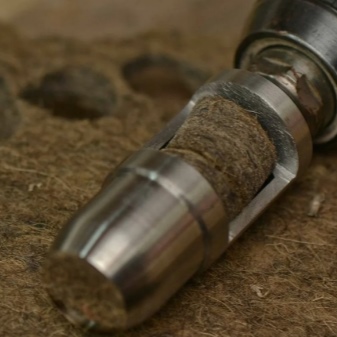
Separately, there is equipment designed for metal work.
- Pneumatic options. Pneumatic models require connection to a compressor. The equipment is suitable for working with different materials in the form of metal tiles, sheet metal, tin.
- Hydraulic models. Punches of this type are similar to machine tools. Using them allows you to make holes in metal.
- Hand tools. The hand punch for metal is more similar to the analog for leather products, but it also has differences. Hard steel is used in the production of equipment. Thanks to the thick base, the tool deforms less when plunging into the base.
Equipment that is used for metalworking quickly begins to become less sharp, so periodic sharpening is required for such a tool. It is important to sharpen the punch not only on the outside, but also on the inside by polishing it.
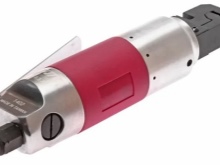
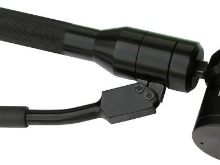
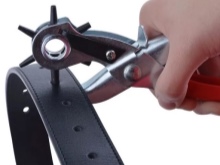
Selection Tips
Working with leather, many novice craftsmen do not know which punchers to give preference to, which option is better to choose. The choice of quality equipment will allow you to efficiently and quickly mark the material, piercing and punching holes, choosing the right size and shape.
- When choosing a model, you should pay attention to the oval punch.
- Figured models allow you to make holes in the form of a drop, a flower, a crescent moon, a butterfly and other figures intended for finishing leather goods.
- The slot punch is an indispensable tool for making leather belts.
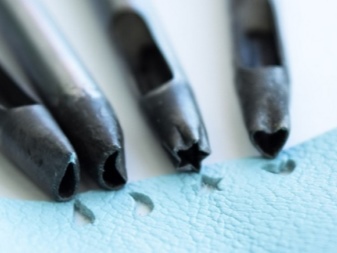
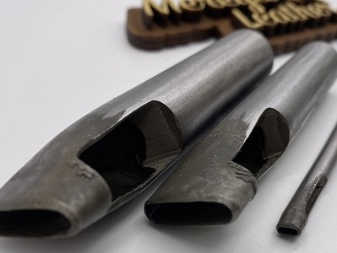
Taking into account the recommendations of experts, it is worth buying nibbling round punches with a pitch of 4 and 5 mm, as well as choosing a less expensive set of diamond-shaped models. When choosing, you should pay attention to the quality of the teeth, they are polished and unpolished. Working with a punch with polished teeth will be much faster, because they pierce through thick layers of leather without problems, which cannot be said about their unpolished counterparts. That is why such products are much cheaper than their polished counterparts. For rare use, simple, inexpensive models are suitable. Professionals should choose more reliable, expensive devices.
When choosing a tool, experts suggest purchasing products from the USA, Germany, and Japan. Chinese hole punches are quite popular, but they do not always have the required quality. It is important that the tools are made of durable steel.
It is desirable that the cutting surface in the form of a point, nozzles or punches be additionally subjected to diamond processing or hardening.
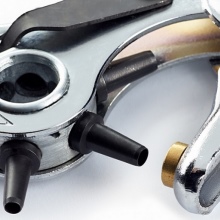
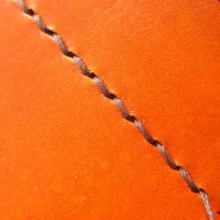

How to use it correctly?
If it is necessary to punch a hole on the leather belt, a specially designed hole punch is suitable. The model of the Chinese manufacturers LAOA LA111353 is an excellent option for household use. Punching a hole on the belt with such a device is not difficult.
- It is necessary to take the belt and measure the place where the hole should be.
- Take a punch and select the diameter so that the tool fits snugly into the hole.
- It is important that the spacing between the holes is the same and the mark is in line.
- After measuring the data and comparing the interval, the apparatus is placed on the mark and the handles are pressed, pressing on them. The force of pressing must correspond to the rigidity of the material.
- When pressed, a click will be heard, leaving a piece of the cut material inside the tool.
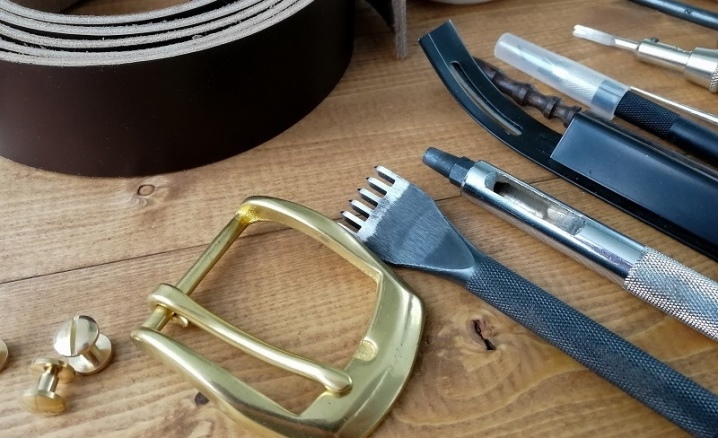
Alignment and spacing are essential. If you do not adhere to these parameters, the holes will not be on the same line, above or below the original. By punching strictly in the center and adhering to the interval, you can get a hole that will not differ in any way from factory work.
Such a punch is used not only for holes on the belt, it is also used for setting buttons on things, especially for children. Remove the device from the material vertically, without swinging it.
The punch will last longer if you put a special substrate in the form of a polymer plate on a flat table under the skin.
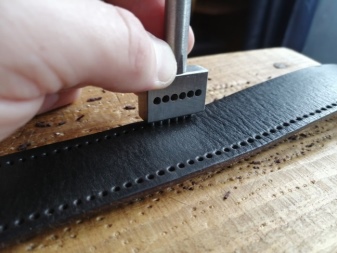
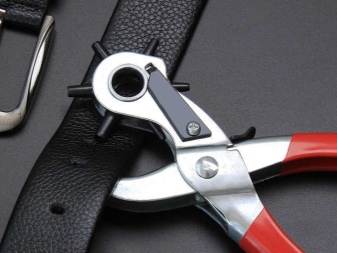













The comment was sent successfully.